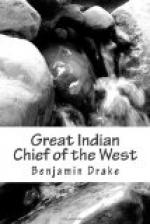In the course of the preceding pages, the difficulty of procuring full, and always exact information, in regard to the lives of a people having neither records nor historians, has been alluded to. This difficulty will be encountered by any one who may attempt to chronicle the annals of the aborigines in their aggregate condition, or to portray their individual history. In the compilation of this volume, much pains were taken to obtain all the prominent events in the life of Black Hawk, and, it is supposed, as much success attended the effort, as is usual in similar cases. Since its publication, however, it appears that all his military movements have not been narrated, and we proceed to supply the omission.
At page 82 of this volume, it is stated that Black Hawk was only in two engagements in the late war with Great Britain, and that the last of these was the assault upon Fort Stephenson, in August 1813, then under the command of Major Groghan. It is true that he and his band were with the British army in the attack upon this post, but his connection with that army did not cease until after the capture of Fort Erie. The authority for this fact is to be found in the “Book of the Indians,” page 145. The author of that work, in narrating the incidents of Black Hawk’s return to the north-west, in 1833, after his imprisonment at Fortress Monroe, says: “Having arrived at Buffalo, on Friday the 28th of June, they (the party returning with the old warrior) remained there until Sunday morning. The day after their arrival, they rode over to Black Rock, where they viewed the union of the grand canal with the lake at that place. From this point they had a full view of the Canada shore, and Black Hawk immediately pointed out Fort Erie, and seemed well acquainted with the adjacent country; he having been there in the time of the last war with England, in the British service; and at the time ‘when the Americans walked into Fort Erie,’ as he expressed the capture of it.” Of the extent of his participation in the events attendant upon this capture, there is no satisfactory information.
Black Hawk was likewise in the battle of the Thames, a fact not previously stated in this work, and which is now given on the authority of a writer in the Baltimore American, to whose respectability the editor of that paper bears testimony. We have, indeed, no reason to doubt the accuracy of this statement, which will be read with the more interest, from the circumstance that it embraces Black Hawk’s account of the death of Tecumthe in regard to which much has been written and published. It is not proposed, on the present occasion, to compare the relation given by Black Hawk, of the fall of Tecumthe, with the testimony of others who have appeared as historians of this event, but shall content ourselves with simply quoting the article to which reference has been made. The writer professes to have been intimately acquainted with Black Hawk, and in the brief sketch which he has presented of the life of this warrior, we find corroborating evidence of the truth of many of the traits of character, which, in the course of this volume, has been assigned to him both as a man and a warrior. The article is in these words:




